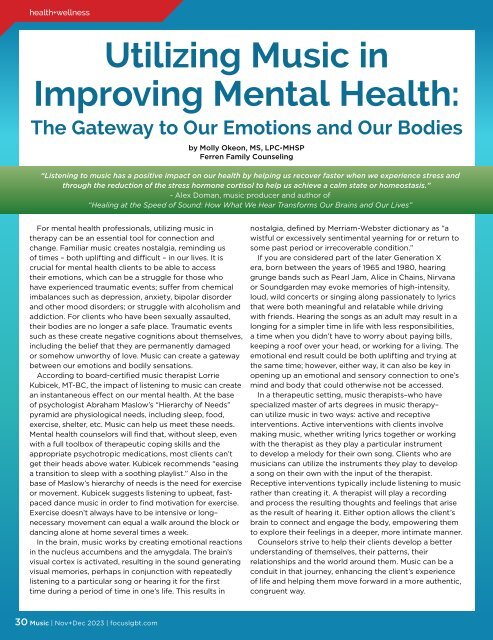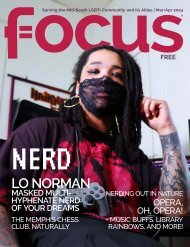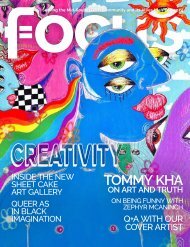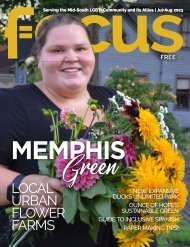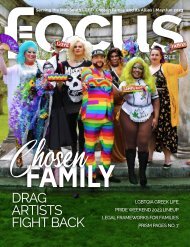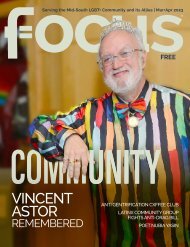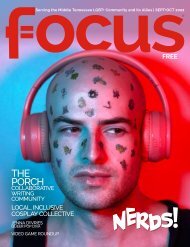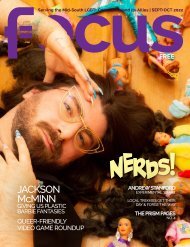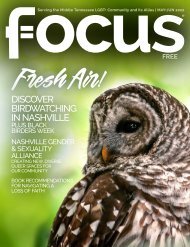Create successful ePaper yourself
Turn your PDF publications into a flip-book with our unique Google optimized e-Paper software.
health+wellness<br />
Utilizing Music in<br />
Improving Mental Health:<br />
The Gateway to Our Emotions and Our Bodies<br />
by Molly Okeon, MS, LPC-MHSP<br />
Ferren Family Counseling<br />
“Listening to music has a positive impact on our health by helping us recover faster when we experience stress and<br />
through the reduction of the stress hormone cortisol to help us achieve a calm state or homeostasis.”<br />
- Alex Doman, music producer and author of<br />
“Healing at the Speed of Sound: How What We Hear Transforms Our Brains and Our Lives”<br />
For mental health professionals, utilizing music in<br />
therapy can be an essential tool for connection and<br />
change. Familiar music creates nostalgia, reminding us<br />
of times – both uplifting and difficult – in our lives. It is<br />
crucial for mental health clients to be able to access<br />
their emotions, which can be a struggle for those who<br />
have experienced traumatic events; suffer from chemical<br />
imbalances such as depression, anxiety, bipolar disorder<br />
and other mood disorders; or struggle with alcoholism and<br />
addiction. For clients who have been sexually assaulted,<br />
their bodies are no longer a safe place. Traumatic events<br />
such as these create negative cognitions about themselves,<br />
including the belief that they are permanently damaged<br />
or somehow unworthy of love. Music can create a gateway<br />
between our emotions and bodily sensations.<br />
According to board-certified music therapist Lorrie<br />
Kubicek, MT-BC, the impact of listening to music can create<br />
an instantaneous effect on our mental health. At the base<br />
of psychologist Abraham Maslow’s “Hierarchy of Needs”<br />
pyramid are physiological needs, including sleep, food,<br />
exercise, shelter, etc. Music can help us meet these needs.<br />
Mental health counselors will find that, without sleep, even<br />
with a full toolbox of therapeutic coping skills and the<br />
appropriate psychotropic medications, most clients can’t<br />
get their heads above water. Kubicek recommends “easing<br />
a transition to sleep with a soothing playlist.” Also in the<br />
base of Maslow’s hierarchy of needs is the need for exercise<br />
or movement. Kubicek suggests listening to upbeat, fastpaced<br />
dance music in order to find motivation for exercise.<br />
Exercise doesn’t always have to be intensive or long–<br />
necessary movement can equal a walk around the block or<br />
dancing alone at home several times a week.<br />
In the brain, music works by creating emotional reactions<br />
in the nucleus accumbens and the amygdala. The brain’s<br />
visual cortex is activated, resulting in the sound generating<br />
visual memories, perhaps in conjunction with repeatedly<br />
listening to a particular song or hearing it for the first<br />
time during a period of time in one’s life. This results in<br />
nostalgia, defined by Merriam-Webster dictionary as “a<br />
wistful or excessively sentimental yearning for or return to<br />
some past period or irrecoverable condition.”<br />
If you are considered part of the later Generation X<br />
era, born between the years of 1965 and 1980, hearing<br />
grunge bands such as Pearl Jam, Alice in Chains, Nirvana<br />
or Soundgarden may evoke memories of high-intensity,<br />
loud, wild concerts or singing along passionately to lyrics<br />
that were both meaningful and relatable while driving<br />
with friends. Hearing the songs as an adult may result in a<br />
longing for a simpler time in life with less responsibilities,<br />
a time when you didn’t have to worry about paying bills,<br />
keeping a roof over your head, or working for a living. The<br />
emotional end result could be both uplifting and trying at<br />
the same time; however, either way, it can also be key in<br />
opening up an emotional and sensory connection to one’s<br />
mind and body that could otherwise not be accessed.<br />
In a therapeutic setting, music therapists–who have<br />
specialized master of arts degrees in music therapy–<br />
can utilize music in two ways: active and receptive<br />
interventions. Active interventions with clients involve<br />
making music, whether writing lyrics together or working<br />
with the therapist as they play a particular instrument<br />
to develop a melody for their own song. Clients who are<br />
musicians can utilize the instruments they play to develop<br />
a song on their own with the input of the therapist.<br />
Receptive interventions typically include listening to music<br />
rather than creating it. A therapist will play a recording<br />
and process the resulting thoughts and feelings that arise<br />
as the result of hearing it. Either option allows the client’s<br />
brain to connect and engage the body, empowering them<br />
to explore their feelings in a deeper, more intimate manner.<br />
Counselors strive to help their clients develop a better<br />
understanding of themselves, their patterns, their<br />
relationships and the world around them. Music can be a<br />
conduit in that journey, enhancing the client’s experience<br />
of life and helping them move forward in a more authentic,<br />
congruent way.<br />
30 Music | <strong>Nov</strong>+<strong>Dec</strong> <strong>2023</strong> | focuslgbt.com


